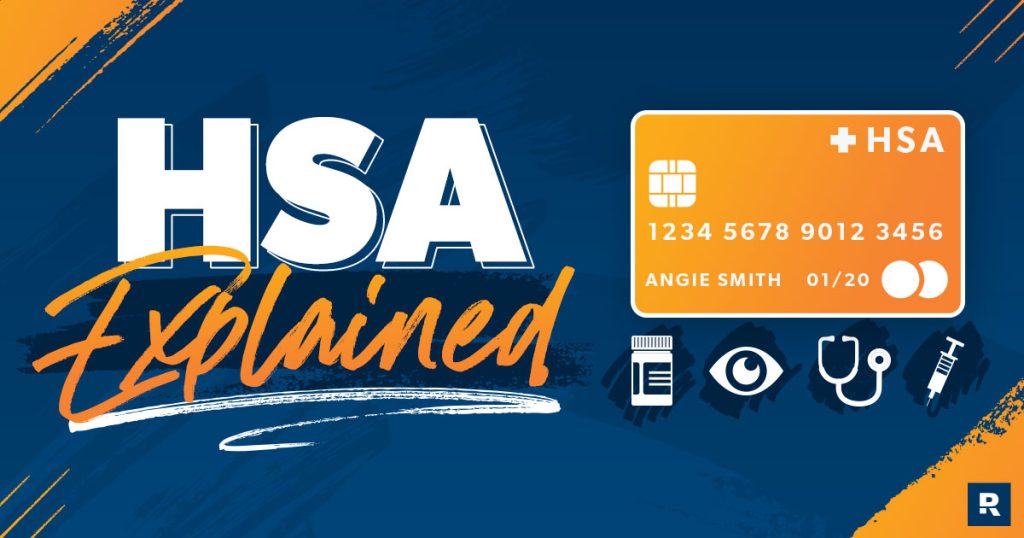With health insurance premiums and costs rising each year, it’s no surprise that folks are always looking for ways to save money on medical expenses.
That’s where the Health Savings Account (HSA) comes in.
HSAs are pretty popular nowadays. Approximately 34 million people use them to save and pay for medical expenses.1 But you may be asking, What is a Health Savings Account? How does it work? And is it the best option for my family?
Let’s take a closer look at some of the most common questions people ask about Health Savings Accounts—and learn how an HSA can help you save money on medical expenses!
What Is an HSA?
HSAs are tax-advantaged savings accounts that can help you pay for medical expenses tax-free now and in the future. It’s like an extra emergency fund just for medical costs!
You have to be enrolled in a high-deductible health plan (HDHP) to get a Health Savings Account. A higher deductible basically means you’ll need to pay more out of pocket before your insurance kicks in. But in exchange, you get lower monthly premiums and the option to put money into an HSA to save up for your medical costs.
Am I Eligible for an HSA?
As mentioned above, you have to have an HSA-eligible high-deductible health plan to open up an HSA or put money into one. No exceptions. You can find an HSA-qualified health plan through your employer (if they offer one) or an independent insurance agent.
For 2022, an HDHP must have a minimum annual deductible of $1,400 for single coverage and $2,800 for family coverage.2 The out-of-pocket maximum (which includes your deductible, copayments and coinsurance, but not your premiums) is $7,050 for singles and $14,100 for families.3 That’s the most you’ll pay for medical costs before your insurance covers 100% of the rest.
Here are the numbers for 2023: An HDHP must have a minimum annual deductible of $1,500 for single coverage and $3,000 for family coverage.4 The out-of-pocket maximum bumps up to $7,500 for singles and $15,000 for families.5
If you’re enrolled in Medicare or someone claims you as a dependent on their tax return, sorry, you won’t be able to open or contribute to a Health Savings Account.
|
2022 |
2023 |
|
|
HDHP Minimum Annual Deductible (Individual Coverage) |
$1,400 |
$1,500 |
|
HDHP Minimum Annual Deductible (Family Coverage) |
$2,800 |
$3,000 |
|
Out-of-Pocket Maximum (Individual Coverage) |
$7,050 |
$7,500 |
|
Out-of-Pocket Maximum (Family Coverage) |
$14,100 |
$15,000 |
How Does an HSA Work?
In most cases, your HSA acts like a savings account at first and earns interest the same way a normal savings account does. Other Health Savings Accounts let you invest the money in mutual funds right away—just like an IRA! Some providers require a minimum balance before you can start investing your HSA funds, so do your research ahead of time.
Investing your HSA funds and letting that money grow over the long haul can help you start building up enough savings to cover medical expenses during your retirement years. That’s huge!
Your HSA also comes with some great tax advantages:
1. You’re not taxed when you put money into your HSA account.
Generally, there are two ways you can put money into an HSA. Your HSA contributions can come straight out of your paycheck through a pretax payroll deduction, or you could make deposits into your HSA on your own and claim them as tax deductions when you do your income taxes.
Either way, you won’t be paying taxes on the money you put into your Health Savings Account!
2. The money in your HSA also grows tax-free.
Once that money is in your account and starts earning interest, you won’t be taxed for growth like you might with other types of accounts that earn interest. Whenever you see the words tax-free and growth in the same sentence, your ears should perk up a little bit!
The ability to take advantage of tax-free growth makes the HSA a nice addition to your retirement portfolio. If you’re maxing out your 401(k) and IRA contributions and are looking for another place to invest, your HSA is a great place to start.
3. You’re not taxed when you take money out to pay for medical expenses.
As long as you use your HSA money to pay for qualified medical expenses, you won’t be hit with any taxes or penalties.
Another great thing about HSAs:
Once you turn 65, your HSA acts like a traditional IRA. At that point, you can take out money for anything you’d like, but you’ll pay taxes on it when you do—just like a traditional IRA.
However, you can still pay for medical expenses in retirement from your HSA tax-free! That makes using a Health Savings Account the best option for covering health costs in your golden years.
When you combine tax-free contributions with tax-free growth and tax-free withdrawals for medical expenses, that’s like getting a government match on your health care savings!
What Are Qualified Medical Expenses?
Here are just some of the most common qualified medical expenses you can use your tax-free HSA dollars for:
- Dental treatment
- Doctor’s office visits and copays
- Surgery (except cosmetic surgery)
- Eye exams and eyeglasses
- Flu shots
- Physical therapy
- Drug prescriptions and over-the-counter medicines6
It’s also important to know what doesn’t count as a qualified health expense, because you’ll pay income tax and additional penalties for using your HSA dollars for those things.
Sorry, but your gym membership and those essential oils you use for aromatherapy probably don’t count as qualified medical expenses. If you have a question about whether or not something is a qualified health expense, get in touch with your HSA provider to clear up any confusion.
When Should I Start Contributing to an HSA?
The temptation to contribute to an HSA ASAP may be strong, but hold on a sec. You want to wait for the right time. When you work the 7 Baby Steps, you learn exactly how to save for emergencies, pay off all your debt, and build wealth. And yep, you guessed it, there’s a plan for when and how to fit an HSA into the Baby Steps.
Baby Steps 1–3
If you don’t have a $1,000 emergency fund in place (Baby Step 1), if you’re paying off debt other than your mortgage (Baby Step 2), or you don’t have your 3–6-month emergency fund set up (Baby Step 3), then you should not open or contribute to an HSA. (There are a couple of exceptions which we’ll get to.)
When you’re on Baby Steps 1–3, you’re throwing every available penny you have at debt or into an emergency fund. That’s it. You’ve got to get a strong foundation in place first before you start adding on to it.
What if you already have an HSA open though? Hit the pause button and stop your contributions. This is only temporary! The sooner you blast through your debt and get your 3–6-month emergency fund locked down, the sooner you can get back to adding to your HSA. But if you know you have an upcoming medical expense and you already have an HSA open, then contribute just what you need to cover that expense. Nothing more.
Is there ever a time when you should open an HSA in Baby Steps 1–3?
Yes, but only in two scenarios! And remember, if you don’t fall into one of these two categories, then wait until Baby Step 4.
1. You have an upcoming predicted medical expense.
Let’s say you know you’re going to have a baby in five months. That’s an HSA-qualified medical expense. (And let’s face it, having a baby isn’t cheap. You’ll want to take advantage of those tax-free contributions and withdrawals.) If you have your HSA contributions set up as a pretax payroll deduction, then you already have that money going straight into your HSA. Just remember to pause your contributions as soon as you hit the amount you need to cover your medical expense or your max contribution limit, whichever is lower. (More on contribution limits in just a minute!)
If you don’t have a pretax payroll deduction set up and you’ll be making deposits to your HSA on your own, then you need to set up your HSA contributions as a sinking fund instead. A sinking fund is an account where you put money each month for expenses that you know are coming (hello, Christmas and car repairs). Treating your HSA as a sinking fund is one way to plan for predicted medical expenses. You’ll create an HSA sinking fund in your budget, and then once you’ve contributed enough to cover the expense, stop adding to it.
2. Your employer doesn’t offer dental or vision coverage.
You can use an HSA to cover qualifying dental or vision expenses. Again, you should only be contributing what you need to cover the expense. Everything else is going toward debt or building out your emergency fund.
Now, say you’re in Baby Steps 1–3 and your employer matches HSA contributions. Should you contribute to your HSA to get the match? It’s simple: no. If you’re in debt and don’t have an emergency fund, then that’s where all your attention (and money) needs to be going. The match can wait.
Again, if you have a predicted medical expense or your employer doesn’t offer dental or vision coverage, you can contribute just up to the amount you need in order for your employer’s match to make up the rest of the predicted expense. Then like before, stop contributing. You shouldn’t stop paying on your debt just to get the match.
Baby Step 4
Woo-hoo! You’ve made it to Baby Step 4. Not only does that mean you’re 100% debt-free and have a fully funded emergency fund, it also means you can start contributing to an HSA if you have an HSA-qualified health plan! Now that you’ve got a rock-solid foundation, it’s time to take things to the next level.
In Baby Step 4, you can fire up contributions to your HSA again if you’ve had them on pause. Or you can open an HSA account if you don’t have one. Then you can start maxing out your contributions. (We’ll explain more about contribution limits below.)
Baby Step 4 means you’re investing 15% of your household income to save for retirement. And your HSA can play a role in your long-term investment strategy. One of the lesser-known perks of an HSA is that you can invest those funds as they grow.
An HSA is not a use-it-or-lose-it kind of deal. If you don’t use all your HSA funds at the end of the year, they roll over and keep growing, tax-free. Then you can invest those funds just like you would in an IRA.
OK, but listen up! This is important. Your HSA is not part of your initial 15% investment toward retirement. If you want to invest more than 15% of your income, your HSA is where you can do that. Make those funds a line item in your budget.
Baby Steps 5–7
Once you’re on Baby Steps 5–7, you’re sittin’ pretty! Keep maxing out those HSA contributions each year and continue to invest them. This is what building wealth looks like.
How Much Should I Put Into My HSA?
There are limits to how much you can put into your HSA every year (see table below), so pay careful attention to those as you save money into your account. The IRS sets the limit, and they’re happy to hit you with a penalty if you go over it.
Remember, don’t start putting money into your Health Savings Account until you have a fully funded emergency fund, or unless you have a known medical event coming up. If you’ve got a baby on the way or a big surgery planned and you want to pile enough cash into your HSA to cover that event in a given year, go for it. Otherwise, make sure your regular emergency fund is taken care of first.
If you’re debt-free with an emergency fund, go ahead and put whatever amount you’re comfortable with into your HSA (up to the limit). Just make sure to add your HSA contributions to your monthly budget!
Is There a Limit to How Much I Can Contribute to My HSA?
We know you’re probably thinking, All this sounds great, but there’s gotta be a catch! Well, there is one thing: Just like with a Roth IRA or 401(k), there are contribution limits on how much money you can put into your HSA each year.
|
2022 |
2023 |
|
|
HSA Contribution Limits for Single Coverage (Employee + Employer) |
$3,650 |
$3,850 |
|
HSA Contribution Limits for Family Coverage (Employee + Employer) |
$7,300 |
$7,750 |
|
HSA Catch-Up Contributions (Age 55 and older) |
+$1,000 |
+$1,000 |
The chart above shows the maximum you can put in each year, including any money your employer contributes.7,8
What Happens to My HSA if I Leave My Job or Switch Health Plans?
The great thing about having an HSA is that it’s completely yours. So when you get a new job or change health plans, your HSA and all the money in it come with you. You can roll the account into your new employer’s HSA or leave it alone, but those funds are yours to use for qualified expenses either way.
Remember, you have to be enrolled in an HSA-qualified health plan to put money into an HSA. Keep that in mind when you’re changing jobs or health plans. When you switch from an HDHP to a traditional health plan that isn’t qualified for an HSA, you can no longer put money into your existing HSA. You can still use the funds that are in your HSA for qualified medical expenses, though!
What if I Don’t Use All My HSA Funds by the End of the Year?
No medical emergencies? No problem! Your HSA balance rolls over year to year, so you still have access to all the money in the account. If you really want to, you could max out your HSA contributions every year and stockpile as much money as you can. It’s up to you!
Does an HSA-Qualified Health Plan Work for Me?
To figure out if an HSA-qualified health plan works best for your situation, you need to do a good old-fashioned break-even analysis. Time to dust off those calculators and crunch some numbers!
Let’s say your family would save $200 per month on premiums by switching from a traditional health plan to an HDHP. That means you’d save $2,400 each year up front. But at the same time, you’re taking on $3,000 more risk in the form of a higher deductible. You might not max out your deductible in a given year—or you might. You’ll need to make the decision based on your health situation.
How Would an HSA Work in a Medical Emergency?
Having a well-funded Health Savings Account in place can at least take some of the sting out of having to max out your deductible.
Let’s say Jack gets a new job, enrolls in a high-deductible health plan, and starts saving $100 every month in his new HSA. Plus, his new employer matches up to $500 of his HSA contributions each year. Boom! That means $1,700 is going into his HSA every year.
Jack’s a pretty healthy guy, so he’s using his HSA to pay around $600 each year for regular health expenses like dentist appointments, eye exams and the occasional trip to the doctor’s office.
After five years, he has $5,500 saved up in his HSA. But then he hurts his knee in a company softball game. After a trip to the emergency room, a surgery and a few days in the hospital, he gets hit with a $40,000 medical bill.
Jack freaks out for a few minutes before he remembers his health plan has a $2,500 deductible with 20% coinsurance and an out-of-pocket maximum of $5,000, which means:
- First, he’ll need to pay $2,500 to meet the deductible.
- His 20% coinsurance means he’s responsible for 20% of what’s left of the $37,500 medical bill. Yikes! But since Jack’s out-of-pocket maximum is $5,000, he’s only on the hook for that amount ($5,000). His insurance company is going to cover the rest. Yay!
Jack will be able to pay for all those expenses with his HSA savings and still have $500 left in his HSA account. That HSA he’s been putting money into for years comes in handy when Jack needs it the most, helping him cover his deductible and out-of-pocket costs without having to dip into his regular emergency fund or other cash accounts.
That’s exactly what a well-funded HSA is designed to do!
HSA vs. FSA: What’s the Difference?
Like HSAs, Flexible Spending Accounts (FSAs) can also help you save up for medical expenses without paying taxes on the money you contribute to your account. But in an ironic twist, FSAs are actually not as “flexible” as HSAs. Go figure!
Here are some of the key differences between the HSAs and FSAs:
- FSAs are only available through an employee benefits package. So if you’re self-employed, FSAs are not an option.
- You can’t invest the money you put into an FSA, so your money doesn’t have a chance to grow the same way money in an HSA can.
- If there are any funds left in your FSA at the end of the year, you can’t rollover those funds year after year. Instead, those funds expire and revert back to your employer. (There is one exception, which is when your employer allows rollovers . . . but the IRS limits these rollovers to $610 per year for 2023.)9
But don’t completely write off the FSA! There is one benefit that could make them a very appealing option for you and your family: You can use your FSA to pay for childcare costs, something you can’t do with an HSA.
How to Get an HSA
Now that you know what an HSA is and how much it can do for you financially, you might be wondering what the best way to get one is. Well, like we said above, the first step to opening an HSA account is to get an HSA-qualified HDHP (high-deductible health plan). If you have an HSA-qualified health plan already, then get going! It’s time to start saving tax-free dollars for your health care costs. And if you have questions about any of this stuff, don’t worry—there are people who can help.
Our RamseyTrusted partner Health Trust Financial has a team of the best health insurance experts. One of their independent insurance agents will guide you through your insurance options and help you figure out whether an HDHP is right for you.
Read the full article here










